Papers by Ştefan Marius Deaconu
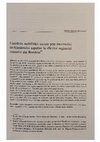
„România de la comunism la postcomunism. Criză, transformare, democratizare” - Anuarul Institutului de Investigare a Crimelor Comunismului şi Memoria Exilului Românesc, 2020
In this article, I analyse how higher education contributed to students’ social mobility in the l... more In this article, I analyse how higher education contributed to students’ social mobility in the last decade of the communist regime in Romania. By assessing a series of defining features of the development of the education system in the 1980s, I underline the limits of higher education social mobility in the period of reference. Despite of the theoretical expectations that an increase in the number of student quotas in higher education and the diversification of the degrees would facilitate students’ social mobility, the reality proved different. In the first part of the period of reference this drawback was caused by political interference that favoured the exclusion of certain social categories from universities and by the consequences of the bureaucratic apparatus reform pushed by the RCP, while later being generated by the socioeconomic volatility of the economic crisis. Another factor contributing to this situation was the decrease in the theoretical retention rate of high school graduates into higher education in the context of a strong demographic boom caused by the effects of Decree no. 770/1966 and other pro‑natality policies. Lastly, the economic factor was also important, since it generated precarious study conditions especially in the second part of the 1980s, when Romania was facing an acute economic crisis. The crisis determined significant changes in higher education policies, notably the decrease of student quotas and their allocation mostly for part‑time and no attendance programs. These structural changes were advantageous for the state apparatus, but restricted the social mobility of the students.
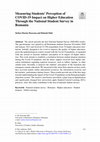
Curaj, A., Salmi, J., Hâj, C.M. (eds) Higher Education in Romania: Overcoming Challenges and Embracing Opportunities. Springer, Cham, 2022
The article presents the first National Student Survey (NSS-RO) results. The questionnaire was op... more The article presents the first National Student Survey (NSS-RO) results. The questionnaire was opened to all Romanian students between November 2020 and January 2021 and involved 23,796 respondents from 76 higher education institutions. Initially designed to be a tool to improve the quality of higher education, given the epidemiological context created with the Covid-19 pandemic, it expanded with one section to measure students' perception of its impact on higher education. This work intends to establish a correlation between student dropout intention during the Covid-19 pandemic and the direct support received from higher education institutions regarding material resources, such as tablets, laptops, or other similar tools. Secondly, it analyses the students' perception of the transition into emergency remote education. We measured in this sense their opinion on how easily they accessed mainly online educational resources, the information received, and the teachers' performance during classes. These results provide one of the first steps towards understanding the impact of the Covid-19 pandemic on the Romanian higher education system. The massive interference provoked a giant leap in digitalisation and significantly changed how universities apply Student-Centred Learning (SCL) practices. Also, this study contributes to the area of national student surveys.
Crisia, 2020
The article analyses the context in which Decree no. 158/1970 and Decree no. 54/1975 were adopted... more The article analyses the context in which Decree no. 158/1970 and Decree no. 54/1975 were adopted. These represented the expression of the state policy regarding the distribution of higher education graduates in Romania in the 1970s. If in the period 1970-1974 we can discuss a “humanized” policy on distribution, in the second part of the decade we are witnessing a sharp anti-meritocracy attitude and regulations that have significantly limited the individual choices of graduates. They also generated an “uprooting” of young people entering the labour force. The two decrees are, at the same time, suggestive for the way in which the Romanian Communist Party related to the young intellectuals during the analysed decade.
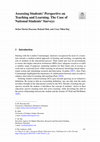
European Higher Education Area: Challenges for a New Decade, 2020
Starting with the London Communiqué, ministers recognized the need of a transition towards a stud... more Starting with the London Communiqué, ministers recognized the need of a transition towards a student-centred approach of learning and teaching, recognizing the role of students in the educational process. Their stated aim was for governments to ensure that higher education institutions (HEIs) have adequate resources to fulfil a complex range of purposes: preparing students for their future role in society, at work and at a personal level, while ensuring an advanced, knowledge-based educational system and stimulating research and innovation.(London 2007). Also, Paris Communique highlighted the importance of collaboration between states in order to enhance innovation in learning and teaching (Paris 2018). Defining student-centred learning (SCL) goes beyond agreeing on an exhaustive definition. By trying to find an overarching definition, one can only note the main novelties brought in the educational system by the SCL. Besides switching the perspective towards the student, it introduces the concept of students’ choice in their education, passive learning turns into active learning, while describing the shift in the power relationship between the student and the teacher (O’Neill and McMahon 2005).
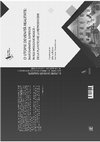
O utopie devenită realitate: învățământul superior în RSS Moldovenească - de la planificare la reproducere, 2020
The mobility of students and teachers in a higher education system represents an indicator of its... more The mobility of students and teachers in a higher education system represents an indicator of its openness to international collaboration. Faced with significant economic problems, the communist bloc states made cuts in the budgets allocated for the network of tertiary education institutions.
In this context, mobility was one of the principal ways of personal development in academia. It was of the paths to be part of flow of scientific information. The study aims to analyse how the signing of the Prague Convention, concluded on June 7, 1972, boosted mobility within the communist bloc.
The analysis starts from an examination of the situation in Romania in the last two decades of the communist regime, being also investigated by the mobility flows between the academic environments in Eastern European countries. The study uses materials from the Archive of the Ministry of Education and Education, and from the Central Committee of the PCP.
Buletinul Cercului de Ideologii Politice şi Mentalităţi, 2014
Interwar Romanian Students' movement was well-known for its anti-Semitic beliefs. Throughout this... more Interwar Romanian Students' movement was well-known for its anti-Semitic beliefs. Throughout this article, we will try to present the most important aspects regarding The Second National Orthodox Students' Congress, which was held in Oradea in December 1927 and its consequences. Subsequently, this paper will present the Opening ceremony and some important issues that were discussed in the first two days of the Congress. Further, we will present some international reactions to this pogrom - as it was and it is largely considered in historiography. This article presents also the trial and some hypothesis largely spread about the way that turbulences had begun.
Gaudeamus. Alma Mater Crisiensis, 2015
This paper presents one of the most innovative concepts in European Union history based on Altier... more This paper presents one of the most innovative concepts in European Union history based on Altiero Spinelli's work. The Italian socialist MEP was behind of some important decisions regarding European Union enlargement and other European policies during the mid 80's. The Crocodile Club, a lobby group based in the Ctocodile Restaurant in Brussels was one of the most astonishing political construction in the European Parliament. Its activity was reassembled in treaties such as the one signed at Fontainebleau in 1984 or Milan in the same year.
Buletinul Cercului de Ideologii Politice și Mentalități, 2016
After the Romanian leader, Nicolae Ceauşescu, delivered his speech on July 6, 1971, commonly kno... more After the Romanian leader, Nicolae Ceauşescu, delivered his speech on July 6, 1971, commonly known as The July Theses, some important representatives from Romanian Exile reacted in through articles in some newspapers and cultural magazines abroad. As censorship was likely
increasing, preventing writers in the country to express themselves freely, exile representatives discovered more of cultural disaster that was happening in Romania. This paper tries to reflect how personalities same as Monica Lovinescu, Virgil Ierunca or Mircea Eliade reacted to The July Theses and other Romanian communist regime abuses
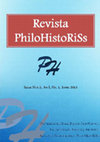
Revista PHILOHISTORISS, Jun 2015
The Socialist Youth Movement in Romania during the first years
after the First World War was clo... more The Socialist Youth Movement in Romania during the first years
after the First World War was closed related to immerging Communist Party. Between 1919 and 1922, Lucrețiu Pătrășcanu was one of the most important leaders of the youth socialists, even though it was a well-known communist. Its work at Tineretul socialist was elaborated, as he manages to succeed to become truly a socialist leader. The battle between old socialists and newly based communist wing for the supremacy in the Social-Democratic Party ended in 1921, when Romanian Communist Party was formed on the first mentioned party base. It was difficult for the communists to inquire and control the socialist youth movement. In 1922, Lucrețiu Pătrășcanu was one of the artisans of the newly formed Union of Communist Youth. The author tries to present the most important moments regarding the formationa of the most important youth structure of Romanian communists during the first years of the interwar period.
Tinerii istorici si cercetarile lor, vol II, Mar 2015
The author of this paper is examining the publicist activity of Lucreţiu Pătrăşcanu during the pe... more The author of this paper is examining the publicist activity of Lucreţiu Pătrăşcanu during the period of 1921 – 1924 as it constitutes one of the best samples of raw wooden language in Romania. Early before and several years after Romanian
Communist Party was constituted, the writers of "Socialismul" and "Tineretul Socialist" implemented for the first time in our country, the so called double speak. Pătrşcanu was one of the most important left sided journalists as it was one of the editor in chief of the two newspapers mentioned earlier. The author focuses on syntax, vocabulary and linguistic style elements as it tries to find similarities and differences between the standard wooden language and the Romanian early interwar one.
Astra Salvensis, 2014
This paper tries to present some of the most important characteristics of the tense relation betw... more This paper tries to present some of the most important characteristics of the tense relation between State and Church between the 10th and 11th centuries, from the latter point of view. After the Gelasian principle was stated, the relationship between regnum and sacerdotium had different stages. After the reigns of Charlemagne and Otto I, the Church was under the economical control of laical authorities. This situation changed from the 10th century as a reform movement started inside the Church. The Papacy had an important role in resetting the Christian institution in the social order and during the pontificate of Gregory VII, the Church reached its highest importance in the Medieval world by that time.

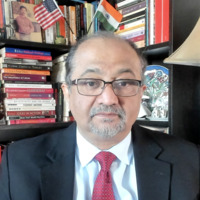


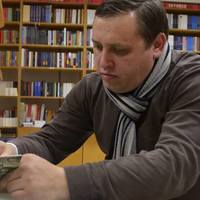




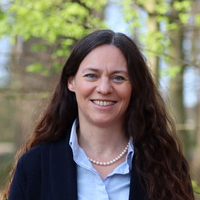
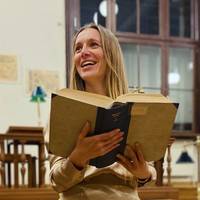
Uploads
Papers by Ştefan Marius Deaconu
In this context, mobility was one of the principal ways of personal development in academia. It was of the paths to be part of flow of scientific information. The study aims to analyse how the signing of the Prague Convention, concluded on June 7, 1972, boosted mobility within the communist bloc.
The analysis starts from an examination of the situation in Romania in the last two decades of the communist regime, being also investigated by the mobility flows between the academic environments in Eastern European countries. The study uses materials from the Archive of the Ministry of Education and Education, and from the Central Committee of the PCP.
increasing, preventing writers in the country to express themselves freely, exile representatives discovered more of cultural disaster that was happening in Romania. This paper tries to reflect how personalities same as Monica Lovinescu, Virgil Ierunca or Mircea Eliade reacted to The July Theses and other Romanian communist regime abuses
after the First World War was closed related to immerging Communist Party. Between 1919 and 1922, Lucrețiu Pătrășcanu was one of the most important leaders of the youth socialists, even though it was a well-known communist. Its work at Tineretul socialist was elaborated, as he manages to succeed to become truly a socialist leader. The battle between old socialists and newly based communist wing for the supremacy in the Social-Democratic Party ended in 1921, when Romanian Communist Party was formed on the first mentioned party base. It was difficult for the communists to inquire and control the socialist youth movement. In 1922, Lucrețiu Pătrășcanu was one of the artisans of the newly formed Union of Communist Youth. The author tries to present the most important moments regarding the formationa of the most important youth structure of Romanian communists during the first years of the interwar period.
Communist Party was constituted, the writers of "Socialismul" and "Tineretul Socialist" implemented for the first time in our country, the so called double speak. Pătrşcanu was one of the most important left sided journalists as it was one of the editor in chief of the two newspapers mentioned earlier. The author focuses on syntax, vocabulary and linguistic style elements as it tries to find similarities and differences between the standard wooden language and the Romanian early interwar one.
In this context, mobility was one of the principal ways of personal development in academia. It was of the paths to be part of flow of scientific information. The study aims to analyse how the signing of the Prague Convention, concluded on June 7, 1972, boosted mobility within the communist bloc.
The analysis starts from an examination of the situation in Romania in the last two decades of the communist regime, being also investigated by the mobility flows between the academic environments in Eastern European countries. The study uses materials from the Archive of the Ministry of Education and Education, and from the Central Committee of the PCP.
increasing, preventing writers in the country to express themselves freely, exile representatives discovered more of cultural disaster that was happening in Romania. This paper tries to reflect how personalities same as Monica Lovinescu, Virgil Ierunca or Mircea Eliade reacted to The July Theses and other Romanian communist regime abuses
after the First World War was closed related to immerging Communist Party. Between 1919 and 1922, Lucrețiu Pătrășcanu was one of the most important leaders of the youth socialists, even though it was a well-known communist. Its work at Tineretul socialist was elaborated, as he manages to succeed to become truly a socialist leader. The battle between old socialists and newly based communist wing for the supremacy in the Social-Democratic Party ended in 1921, when Romanian Communist Party was formed on the first mentioned party base. It was difficult for the communists to inquire and control the socialist youth movement. In 1922, Lucrețiu Pătrășcanu was one of the artisans of the newly formed Union of Communist Youth. The author tries to present the most important moments regarding the formationa of the most important youth structure of Romanian communists during the first years of the interwar period.
Communist Party was constituted, the writers of "Socialismul" and "Tineretul Socialist" implemented for the first time in our country, the so called double speak. Pătrşcanu was one of the most important left sided journalists as it was one of the editor in chief of the two newspapers mentioned earlier. The author focuses on syntax, vocabulary and linguistic style elements as it tries to find similarities and differences between the standard wooden language and the Romanian early interwar one.